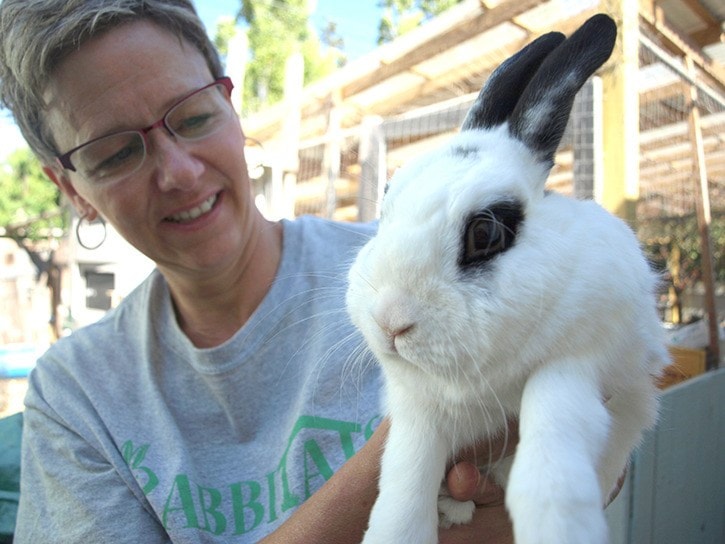Bunny buddies Oreo and Griffin are keeping to themselves this afternoon – their surroundings still new.
Just two weeks ago the fluffy five-year-old rabbits were abandoned outside this South Surrey rabbit sanctuary, home to 110 fellow four-legged friends. The rabbits were left in a tarp-covered cage with a well-meaning note from their owners, who said they were forced to give up their pets due to strata rules.
With a bit of coaxing, Oreo – named for his cookie-coloured coat – comes out of hiding for a visit and willingly rests in the arms of Kathy Lucier, caretaker in chief at Rabbitats Rabbit Rescue.
“I can truly say this is my happy place. They’re just such easy critters to love,” says Lucier.
Rabbitats rescues abandoned rabbits and their feral offspring while promoting an idea to control abandoned pet populations, which can rapidly multiply if left unchecked. It does not encourage animal dumping on their doorstep, as in the case of Oreo and Griffin.
Rabbitats’ goal is to see other property owners establish visually-appealing and comfortable micro-sanctuaries designed to hold small or large rabbit colonies.
Hobby farms, garden centres, farm markets, animal shelters, community centres, care homes and private citizens all have potential to host such sanctuaries, according to founder Sorelle Saidman, who helped establish the first Rabbitats sanctuary a few years ago at Richmond Auto Mall to help control its burgeoning bunny population.
Today the auto mall’s sanctuary has 80 four-legged residents – all spayed or neutered.
The South Surrey sanctuary – located at the back of a rural property not far from the U.S. border – came next. More recently, a small sanctuary of eight rabbits was established nearby at SALI’s Farm, which engages small groups of at-risk children in care-taking activities with animals. Another small group of rabbits has found sanctuary in Langley.
“We’re hoping to get more places,” said Saidman. “We want to do rabbit control. We don’t want it to escalate it to lethal control. We would like to be able to trap whole colonies, get them spayed and neutered, and then relocated to safe locations.”
Part of that challenge is winning over government – which requires rescuers to secure a permit before trapping rabbits in the wild – and convincing policy-makers that sanctuaries provide the best outcome for abandoned rabbits and their offspring.
“We would like to see municipalities sponsor sanctuaries, where we can have animal control, and if people can’t keep their pets, they can bring them into the sanctuary. Right now the shelters are not equipped to handle rabbits.”
Saidman fell into rabbit rescue in 2004 when she came upon an abandoned bunny on a Vancouver street corner.
“I knew nothing about rabbits, didn’t care much about rabbits, until I found one on the street. She came home with me, and I realized after about three days what personalities they had,” she said. “That was it. I was sucked in.”
She later helped facilitate the rescue of nearly 1,000 rabbits from the campus of University of Victoria, after the institution floated a plan to trap and euthanize its feral rabbit population.
Rabbits, she said, are more popular pets than ever, and their populations need to be controlled.
“They’ve been promoted as pets quite heavily… and the unfortunate offshoot of that is more abandoned rabbits. But (pet owners) won’t abandon them on the street if they actually have a safe place to go.”
Left in the wild, pet rabbits can face considerable hardships. They’re vulnerable as prey to other wildlife and may face serious challenges in adequately feeding and sheltering themselves.
Rabbit abandonment in public spaces has become a serious animal welfare issue, according to the B.C. Society for the Prevention of Cruelty to Animals. Abandoning a pet in the wild is an offence under the B.C. Prevention of Cruelty to Animals Act and also violates animal cruelty provisions of the Criminal Code of Canada, the society says.
Some municipalities have hopped on the problem by adopting “progressive” bylaws, according to the society.
Kelowna, Victoria, Saanich and the District of North Vancouver have mandated the spay and neuter of pets sold from pet stores, while Richmond and New Westminster have banned the sale of rabbits from pet stores.
The SPCA says it supports the humane trapping, sterilizing and re-homing of rabbits, but notes on its website not all sanctuaries are well-managed.
“Any animal rescue must prepare carefully by ensuring they have animal health and welfare management plans in place and the financial resources to provide high standards of care to their animals in the long run.”
For its part, Rabbitats has built a roster of volunteers to help care for its furry guests, and has a feeding plan that gives the rabbits a healthy diet of fresh greens and vegetables, supplemented by nutritious pellets. At its South Surrey sanctuary, volunteers care for the rabbits daily, and pens are given a full cleaning each week.
And on this sunny afternoon, Lucier has bags of fresh greens for the Rabbitats residents. Most are hiding in their houses – until they spot the bags of bounty. Then the rabbits come running.
Said Lucier: “You never get bored of watching that.”
